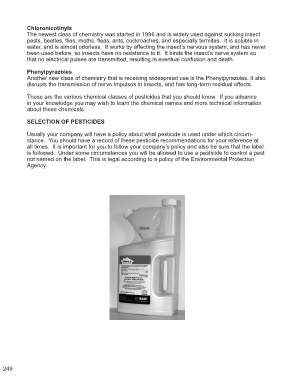Page 249 - Florida Pest Control Examinations
P. 249
Chloronicotinyls
The newest class of chemistry was started in 1996 and is widely used against sucking insect
pests, beetles, flies, moths, fleas, ants, cockroaches, and especially termites. It is soluble in
water, and is almost odorless. It works by affecting the insect’s nervous system, and has never
been used before, so insects have no resistance to it. It binds the insect’s nerve system so
that no electrical pulses are transmitted, resulting in eventual confusion and death.
Phenylpyrazoles
Another new class of chemistry that is receiving widespread use is the Phenylpyrazoles. It also
disrupts the transmission of nerve impulses in insects, and has long-term residual effects.
These are the various chemical classes of pesticides that you should know. If you advance
in your knowledge you may wish to learn the chemical names and more technical information
about these chemicals.
SELECTION OF PESTICIDES
Usually your company will have a policy about what pesticide is used under which circum-
stance. You should have a record of these pesticide recommendations for your reference at
all times. It is important for you to follow your company’s policy and also be sure that the label
is followed. Under some circumstances you will be allowed to use a pesticide to control a pest
not named on the label. This is legal according to a policy of the Environmental Protection
Agency.
249

